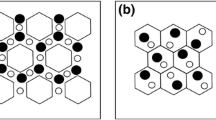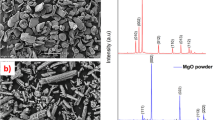Abstract
Among the numerous methods of producing discontinuously reinforced metal-matrix composites, technologies allowing insitu production of the reinforcing phase offer significant advantages from a technical and economic standpoint. The in-situ formation of a ceramic second phase provides greater control of the size and level of reinforcement, yielding better tailorability of the composite properties. As an example, significantly finer ceramic particulates are possible, which minimizes toughness degradation that is traditionally associated with composites containing relatively large particles. Several emerging, innovative technologies in this area are under development. As with any new technology there are technical challenges, but it is believed that these processes have unique capabilities and, thus, they present cost-effective production processes for metal-matrix composites.
Similar content being viewed by others
References
M.J. Koczak and K.S. Kumar, U.S. patent 4,808,372 (March 1989).
P. Sahoo and M.J. Koczak, “Property Microstructural Relationships of In-Situ Titanium Carbide Reinforced Aluminum Alloys” (Paper presented at the First International SAMPE Symposium, Shiba, Japan, 28 November–1 December 1989).
D.J. Skinner et al., “The Microstructural Stability of TiC Reinforced Rapidly Solidified AI-Fe-V-Si Composite Structures,” Metal and Ceramic Matrix Composites, Processing Modelling and Mechanical Behavior, ed. R. Shagat et al. (Warrendale, PA: TMS, 1990).
P. Sahoo and K.J. Koczak, “Elevated Temperature Response of In-Situ TiC Reinforced Aluminum Copper Alloys,” Mater. Sci. Eng., A144 (1990), p. 25.
L. Christodoulou et al., U.S. patent 4,751,048 (14 June 1988).
J.M. Srupbacher et al., U.s. patent 4,836,982 (6 June 1989).
R. Mitra et al., Scripta Metall., 25 (1991), pp. 2689–2694.
T.J. Langan and J.R Pickens, Scripta Metall., 25 (1991), pp. 1587–1591.
P. Davies et al., “Development of Cast Aluminum MMCs,” London Scandinavian Metallurgical Co. Limited (United Kingdom).
S. Khatri et al., “Al2O3/Al-Si Growth by Directed Oxidation of Liquid Aluminum,” International Symposium on the Science of Ceramic Materials (1991), p. 19–24.
S. Khatri et al., “Analysis of Al2O3/Al-Si Composites Fabricated by Directed Oxidation of Aluminum Alloys,” Cer. Eng. Sci. Proc., 13 (1992), p. 485.
A.S. Nagelberg, Processing Science of Advanced Ceramics, ed. I.A Aksay, G.L. McVay, and O.R Ulrich (Pittsburgh, PA: MRS, 1989), pp. 275–282.
M.S. Newkirk et al., Cer. Eng. Sci. Proc., 8(7–8) (1982), pp. 879–885.
M.S. Newkirk et al., J. Mat. Research, 1(1) (1986), pp. 81–89.
O.K. Creber et al., Cer. Eng. Sci. Proc., (7–9) (1988), pp. 975–982.
A.S. Fareed et al., Cer. Eng. Sci. Proc., 11(7,8) (1990), pp. 782–794.
Y. Kagawa, A. Okura and S. Watanabe, Proceedings Fifth Japan-U.S. CCM (Tokyo: Japan Society for Composite Materials, 1990), pp. 79–86.
G.H. Geiger and D.R Poirier, Transport Phenomena in Metallurgy (Reading, MA: Addison Wesley, 1972), p. 19.
A.S. Nagelberg, A. Antolin, and A.W. Urquhart, J. Amer. Cer. Soc. (to be published).
Xiaolu Zeng et al., Mettall. Trans. (to be published).
Int. J. Self Propagating High Temperature Synthesis, 1(1) (1992).
S.C. Giessen, U.S. patent 4,540,546 (10 September 1985).
A.K. Lee et al., Multicomponent Wtrafine Microstructures, ed. L.E. McCandlish et al. (Pittsburgh. PA: MRS, 1989), pp. 87–92.
R.W. Smith and Z.Z. Mutasim, “Plasma Sprayed Refractory Metal Structures and Properties” (Paper presented at the ASM National Thennal Spray Conference, 21–24 May 1990, Long Beach, CA).
R.W. Smith and D. Apelian, “Plasma Spray Consolidation of Materials” (Paper presented at the 9th International Union of Pure and Applied Chemistry Conference on Plasma ChemiStry, September 1989, Bari, Italy).
R.W. Smith, E. Harzenski, and T. Robisch, “The Structure and Properties of Thermally Sprayed TiC Particulate Reinforced Pre-alloyed Powders” (Paper presented at the 12th International Thermal Spray Conference, June 1989, London).
R.W. Smith, D. Apelian, and D. Wei, “Thermal Plasma Materials Processing — Applications and Opportunities,” J. Plasma Chem., 9(1) (1989).
R.W. Smith et al., “The Structure and Properties of Plasma Sprayed TiC Dispersion Hardened Coatings” (Paper presented at the 2nd National Thermal Spray Conference, Cincinnati, OH, October 1989).
A Mortensen and Iljoon Jin, Int. Met. Rev., 37 (1992), p. 101.
Author information
Authors and Affiliations
Rights and permissions
About this article
Cite this article
Koczak, M.J., Premkumar, M.K. Emerging technologies for the in-situ production of MMCs. JOM 45, 44–48 (1993). https://doi.org/10.1007/BF03223365
Issue Date:
DOI: https://doi.org/10.1007/BF03223365




